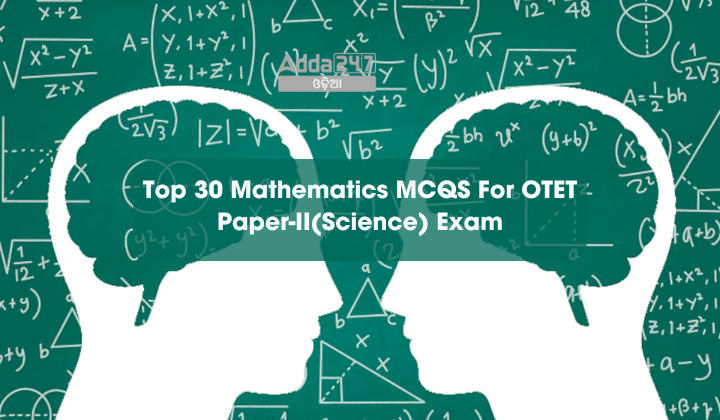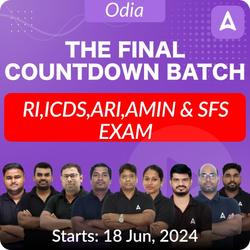Preparing for the Odisha Teacher Eligibility Test (OTET) Paper-II (Science) requires a strong grasp of mathematics concepts relevant to the secondary school curriculum. Here, we present a curated selection of 30 multiple-choice questions (MCQs) covering various topics in mathematics. These questions are designed to help you assess and reinforce your understanding in preparation for the exam.
Top 30 Mathematics MCQS For OTET Paper-II(Science) Exam
- Each angle of the rectangle is:
a. More than 90°
b. Less than 90°
c. Equal to 90°
d. Equal to 45°
Answer: c
Explanation: Let ABCD is a rectangle, and ∠A = 90°
AD || BC and AB is a transversal
∠ A + ∠ B = 180° (Interior angles on the same side of the transversal)
∠ A = 90°
So, ∠ B = 180° – ∠ A = 180° – 90° = 90°
Now, ∠ C = ∠ A and ∠ D = ∠ B (Opposite angles of the parallelogram)
So, ∠ C = 90° and ∠ D = 90°
Hence all sides are equals to 90°. - The angles of a quadrilateral are in the ratio 4: 5: 10: 11. The angles are:
a. 36°, 60°, 108°, 156°
b. 48°, 60°, 120°, 132°
c. 52°, 60°, 122°, 126°
d. 60°, 60°, 120°, 120°
Answer: b
Explanation: Let x be the common angle among all the four angles of a quadrilateral.
As per angle sum property, we know:
4x+5x+10x+11x = 360°
30x = 360°
x = 12°
Hence, angles are
4x = 4 (12) = 48°
5x = 5 (12) = 60°
10x = 10 (12) = 120°
11x = 11 (12) = 132° - If ABCD is a trapezium in which AB || CD and AD = BC, then:
a. ∠A = ∠B
b. ∠A > ∠B
c. ∠A < ∠B
d. None of the above
Answer: a
Explanation: Draw a line through C parallel to DA intersecting AB produced at E.
CE = AD (Opposite sides)
AD = BC (Given)
BC = CE
⇒ ∠CBE = ∠CEB
also,
∠A + ∠CBE = 180° (Angles on the same side of transversal and ∠CBE = ∠CEB)
∠B + ∠CBE = 180° ( As Linear pair)
⇒ ∠A = ∠B - Which of the following is not true for a parallelogram?
(a) Opposite sides are equal
(b) Opposite angles are equal
(c) Opposite angles are bisected by the diagonals
(d) Diagonals bisect each other.
Answer: c
Explanation: Opposite angles are bisected by the diagonals is not true for a parallelogram. Whereas opposite sides are equal, opposite angles are equals, diagonals bisect each other are the properties of a parallelogram. - Three angles of a quadrilateral are 75º, 90º and 75º. The fourth angle is
(a) 90º
(b) 95º
(c) 105º
(d) 120º
Answer: d
Explanation: We know that the sum of angles of a quadrilateral is 360º.
Let the unknown angle be x.
Therefore, 75º+90º+75º+x = 360º
x = 360º – 240º = 120º. - Find the value of x.
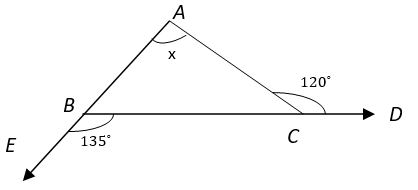
a) 90°
b) 75°
c) 135°
d) 45°
Answer: b
Explanation: From figure, ∠EBC + ∠ABC = 180° (Linear Pair)
⇒ 135° + ∠ABC = 180°
⇒ ∠ABC = 45°
Also, ∠ACB + ∠ACD = 180° (Linear Pair)
⇒ 120° + ∠ACB = 180°
⇒ ∠ACB = 60°
In ∆ ABC, ∠BAC + ∠ABC + ∠ACB = 180° (Angle Sum property of triangle)
⇒ 45° + x + 60° = 180°
⇒ x = 180° – 105°
⇒ x = 75° - Which of the following relation between x and y is correct?
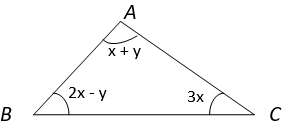
a) x + y = 45°
b) x – y = 180°
c) 3x + y = 90°
d) 3x – y = 90°
Answer: d
Explanation: In ∆ ABC, ∠BAC + ∠ABC + ∠ACB = 180° (Angle Sum property of triangle)
⇒ (x + y) + (2x – y) + (3x) = 180°
⇒ 6x – 2y = 180°
⇒ 3x – y = 90° - Find the angles (∠P, ∠Q, ∠R) of the triangle if a + b = 120° and a – c = 30°.
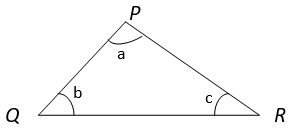
a) 90°, 30°, 60°
b) 90°, 45°, 45°
c) 120°, 30°, 30°
d) 90°, 45°, 80°
Answer: a
Explanation: Given, a + b = 120° ———— (i)
and a – c = 30°———— (ii)
In ∆ PQR, ∠P + ∠Q + ∠R = 180° (Angle Sum property of triangle)
⇒ a + b + c = 180°
⇒ 120° + c = 180° (from equation i)
⇒ c = 60°
Now, from equation ii, a – c = 30°
⇒ a – 60° = 30°
⇒ a = 90°
Also, from equation i, a + b = 120°
⇒ b + 90° = 120°
⇒ b = 30° - Find the angle ∠MQR if QM ⊥ PR and ∠Q = 90°.
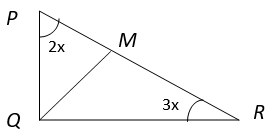
a) 60°
b) 45°
c) 36°
d) 90°
Answer: c
Explanation: In ∆ PQR, ∠P + ∠Q + ∠R = 180° (Angle Sum property of triangle)
⇒ 2x + 90° + 3x = 180°
⇒ 5x = 90°
⇒ x = 18°
Now, In ∆ QMR, ∠MQR + ∠QMR + ∠MRQ = 180° (Angle Sum property of triangle)
⇒ ∠MQR + 90° + 3x = 180°
⇒ ∠MQR = 180° – 90° – 3 x 18°
⇒ ∠MQR = 180° – 90° – 54°
⇒ ∠MQR = 36° - Find the value of x if BO and OC are angle bisectors of angle B and C respectively.
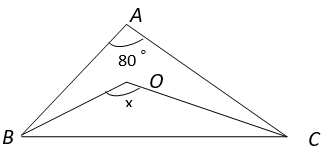
a) 90°
b) 130°
c) 145°
d) 55°
Answer: b
Explanation: In ∆ ABC, ∠BAC + ∠ABC + ∠ACB = 180° (Angle Sum property of triangle)
⇒ 80° + ∠B + ∠C = 180°
⇒ ∠B + ∠C = 100° ————- (i)
Also, In ∆ BOC, ∠BOC + ∠OBC + ∠OCB = 180° (Angle Sum property of triangle)
⇒ ∠BOC + 1/2 ∠B + 1/2 ∠C = 180° (BO and OC are angle bisectors)
⇒ ∠BOC + 1/2 (∠B + ∠C) = 180°
⇒ ∠BOC + 1/2 (100°) = 180° (from equation i)
⇒ ∠BOC = 180° – 50°
⇒ ∠BOC = 130°. - Which of the following statements is true based on the below statements?
i) All integers are rational numbers.
ii) All rational numbers are integers.
a) Both statements are true
b) Statement (i) is true and Statement (ii) is false
c) Statement (i) is false and Statement (ii) is true
d) Both statements are false
Answer: b
Explanation: All integers (e.g., …, -2, -1, 0, 1, 2, …) can be represented as p/q where p and q are integers and q ≠ 0 (e.g., 0/1, 2/1, etc.). Hence, all integers are rational numbers. However, not all rational numbers (e.g., 2/5 which equals 0.4) are integers. - Which of the following is not a rational number?
a) 8/9
b) 5/7
c) -3/2
d) √2
Answer: d
Explanation: A rational number can be represented as p/q where p and q are integers and q ≠ 0. However, √2 cannot be expressed in this form, thus it is not a rational number. - How many whole numbers are there between -3 and 3 (including -3 and 3)?
a) Four
b) Zero
c) Seven
d) Three
Answer: a
Explanation: Whole numbers are {0, 1, 2, 3, …}. Therefore, the whole numbers between -3 and 3 are 0, 1, 2, and 3, totaling four numbers. - N is a subset of W, Z, and Q. (Assume conventional notations)
a) True
b) False
Answer: a
Explanation: N represents the set of natural numbers {1, 2, 3, …}, which are all contained within the sets W (whole numbers), Z (integers), and Q (rational numbers). - Rational numbers are denoted by ______
a) N
b) Z
c) Q
d) W
Answer: c
Explanation: Rational numbers are denoted by Q, which includes all numbers that can be represented as p/q where p and q are integers and q ≠ 0. - If we add, 7xy + 5yz – 3zx, 4yz + 9zx – 4y and –3xz + 5x – 2xy, then the answer is:
A. 5xy + 9yz +3zx + 5x – 4y
B. 5xy – 9yz +3zx – 5x – 4y
C. 5xy + 10yz +3zx + 15x – 4y
D. 5xy + 10yz +3zx + 5x – 6y
Answer: A
Explanation: Given, 7xy + 5yz – 3zx, 4yz + 9zx – 4y and –3xz + 5x – 2xy.
If we add the three expressions, then we need to combine the like terms together.
(7xy – 2xy) + (5yz + 4yz) – 3zx + 9zx – 3xz – 4y + 5x
= 5xy + 9yz + 3zx + 5x – 4y - If we subtract 4a – 7ab + 3b + 12 from 12a – 9ab + 5b – 3, then the answer is:
A. 8a+2ab+2b+15
B. 8a+2ab+2b-15
C. 8a-2ab+2b-15
D. 8a-2ab-2b-15
Answer: C
Explanation: (12a – 9ab + 5b – 3) – (4a – 7ab + 3b + 12)
= 12a – 9ab + 5b – 3 – 4a + 7ab -3b-12
= (12 – 4)a – (9 – 7)ab + (5 – 3)b – 3 – 12
= 8a – 2ab + 2b – 15 - If we multiply 5x and (– 4xyz), then we get:
A. 20x2yz
B. -20x2yz
C. x2yz
D. -2xyz
Answer: B
Explanation: (5x) x (-4xyz)
= 5 × x × (-4) × x × y × z
= -20×1+1yz
= -20x2yz - The product of 4x and 0 is:
A. 4x
B. 4
C. 0
D. None of the above
Answer: C
Explanation: Any value multiplied by zero is zero. - The volume of a cuboid with length, breadth and height as 5x, 3×2 and 7×4 respectively is:
A. 105×7
B. 105×2
C. 105×4
D. 105x
Answer: A
Explanation: Volume of cuboid = Length × breadth × height
V = 5x × 3×2 × 7×4
V = 105 x1+2+4
V = 105×7 cubic units - What is mathematics primarily concerned with?
a) Language
b) Scientific disciplines
c) Numbers, space, and measurement
d) Creative thinking
Answer: c) Numbers, space, and measurement - Which of the following is true about mathematics?
a) It is a subjective field
b) Its principles vary by region
c) It fosters logical thinking
d) It lacks practical applications
Answer: c) It fosters logical thinking - What role does mathematics play in scientific disciplines?
a) It is irrelevant
b) It serves as a foundation
c) It is occasionally used
d) It complicates studies
Answer: b) It serves as a foundation - How does mathematics contribute to children’s development?
a) It hinders self-confidence
b) It promotes unhealthy mindsets
c) It fosters scientific thinking
d) It discourages logical reasoning
Answer: c) It fosters scientific thinking - Which of the following is NOT a strategy for fostering creative thinking in children through mathematics?
a) Encouraging questions and challenges
b) Using fixed problem-solving patterns
c) Creating multiple solution challenges
d) Recognizing novel ideas
Answer: b) Using fixed problem-solving patterns - What is the primary purpose of evaluation in the mathematics classroom?
a) To grade students based on their performance
b) To measure the effectiveness of teaching
c) To organize quiz programs
d) To assign homework assignments
Answer: b) To measure the effectiveness of teaching
Explanation: Evaluation in mathematics education primarily aims to assess how well students are learning and to gauge the effectiveness of instructional methods. - Which of the following best describes diagnostic evaluation in mathematics education?
a) Evaluating students at the end of a unit
b) Assessing student learning during instruction
c) Grading students based on their performance
d) Evaluating homework assignments
Answer: b) Assessing student learning during instruction
Explanation: Diagnostic evaluation involves assessing students’ understanding and learning difficulties during the instructional phase to guide teaching strategies effectively. - What is the distinction between evaluation and measurement in the context of mathematics education?
a) Evaluation involves collecting data, while measurement interprets the data
b) Measurement is the process of assigning grades, while evaluation assesses learning
c) Evaluation measures student performance, while measurement evaluates teaching
d) Measurement is the process of collecting data, while evaluation interprets the data
Answer: d) Measurement is the process of collecting data, while evaluation interprets the data
Explanation: Measurement collects data such as test scores, while evaluation uses this data to assess learning and instructional effectiveness. - When should formative evaluation be conducted in the mathematics classroom?
a) At the beginning of the academic year
b) During the instructional phase
c) At the end of a unit
d) After grading students
Answer: b) During the instructional phase
Explanation: Formative evaluation helps monitor student progress and adjust teaching strategies during the instructional phase to enhance learning outcomes. - What is the role of summative evaluation in mathematics education?
a) To grade students at the end of the academic year
b) To assess learning during instruction
c) To diagnose learning difficulties
d) To guide teaching strategies
Answer: a) To grade students at the end of the academic year
Explanation: Summative evaluation is conducted at the end of a unit, term, or year to assess students’ overall achievement and assign grades.

